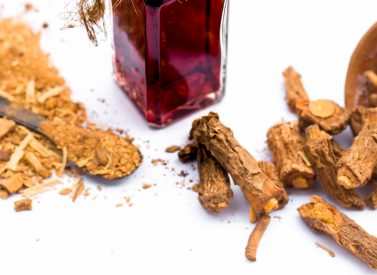Scientific Name: Smilax officinalis
Constituents:
- Steroidal Saponins (parillin, sarsaponin, smilagenin, sarsasapogenin, sarsaparilloside)
- Phytosterols (beta-sitosterol & stigmasterol)
- Flavonoids (Quercitin)
- Oxalic acid
- Fatty acids
- Resin
- Minerals (iodine)
Medicinal actions:
- Alterative
- Anti-inflammatory
- Anti-rheumatic
- Antimicrobial
- Diuretic
- Immunomodulator
- Reproductive Tonic
Mechanism of Action & Pharmacology:
- Steroidal saponins exert hormone modulating effects in the body, and are used in the manufacturing of cortisone & other steroids. May act as a competitive inhibitor for androgens, be metabolized into testosterone or act as phyto-testosterone agents. However, there is no evidence to suggest that the plant will “boost” testosterone levels.
- Saponins bind gut endotoxins, which have been shown to stimulate cGMP (stimulus for the proliferative cell division that occurs in psoriasis) and reduce toxic load within the gut, and have demonstrated anti-proliferative activity against human colon tumor cell lines.
- Parillin has demonstrated antibiotic activity.
- Resin inhibits prostatic hyperplasia, reducing the DHT level in serum and improving the prostate gland morphology in vivo.
- Flavonoids may have phytoestrogenic activity.
- May act as a therapeutic agent of immuno-inflammatory diseases through a selective suppression on the cellular immune response without suppressing humoral immune responses. Direct anti-inflammatory mechanism includes inhibition of PGE2, IL-1, TNF and NO and improving activity of dysfunctional T lymphocytes.
Pharmacy:
- Decoction
- Tincture
- Capsule
Safety & Toxicity Concerns:
- High doses may cause gastric upset and irritation, and long-term use may cause ulceration of the gastrointestinal mucosa and temporary kidney impairment.
Interactions:
- May increase absorption and/or metabolism of some medications (eg. digitalis, bismuth, hypnotics and benzodiazepenes).








